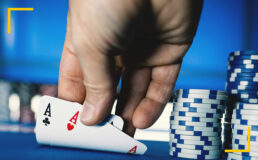Within a poker hand, players have several actions they can take, each with its strategic implications. One such action is the ‘check‘, a move that can be both powerful and deceptive in the right context.
In this article, we’ll explore the ins and outs of poker check, when to use it, and when to avoid it during a round of betting. Let’s dive in!
WHAT IS A CHECK IN A POKER HAND?
 A check occurs when a player chooses not to bet during their turn in the current betting round. Instead of adding chips to the pot, the player merely passes the action to the next person, maintaining their current bet of zero.
A check occurs when a player chooses not to bet during their turn in the current betting round. Instead of adding chips to the pot, the player merely passes the action to the next person, maintaining their current bet of zero.
To check in land-based poker, tapping the table is standard. Some prefer tapping the table while also announcing their check.
MAIN RULES FOR USING CHECK POKER FOR POKER PLAYERS
Just like folding, calling and raising, checking can and should only be done in specific situations.
- Know the Rule: Checking is only possible if no other player has placed a bet in the current betting round. If any player has made a bet, the option to check is no longer available, and the player must either call, fold or raise. Are raises allowed after a check? No. You can check, bet or fold after a check.
- Know the Game: Ensure you have a good grasp of the poker variant you are playing and the specific rules surrounding checking. Nobody wants to deal with someone who doesn’t know how a round of betting unfolds, so tap into a good poker blog before starting your poker match!
- Position Matters: The later your position at the table, the more advantageous checking becomes, as it allows you to gather more information about opponent(s’) intentions.
- Hand Strength Assessment: Use the check to evaluate your hand strength and consider potential bluffs or slow-playing strong hands.
- Beware of Draws: If you’re facing a draw-heavy board, cautious use of the check can save you from being trapped by players’ potential completed hands.
WHEN TO USE CHECK IN POKER GAME?
Most poker players struggle to deal with a check at a poker table. Many players use it too sparingly, while others see no value in it and opt for folding instead, but folded cards cannot win you anything!
Knowing when to check can be a powerful tool in a player’s arsenal, and it can even help you hit the best hand in the game and win. Some strategic moments to consider using a check include:
- Weak Hands: When you hold a weak or marginal hand, a check can be an effective way to avoid losing additional chips in a potentially unfavourable situation.
- Slow Playing: With a strong hand, you may opt for a check to disguise your holding and induce subsequent players to bet, allowing you to check raise and build a more substantial pot.
- Pot Control: In situations where you want to keep the pot small or control the betting action, checking can help you avoid over-committing with a decent but not exceptional hand.
- Showdown: If your opponent(s) have all checked and you are left to act, a check can be a wise move to arrive to showdown. Similarly, you can check during the when seated last to see what the next card
WHEN NOT TO USE POKER CHECK IN A BETTING ROUND?
While checking can be a valuable move, there are specific scenarios where using it may not be the best course of action:
- Missed Opportunities: When you have a strong hand, betting or raising may be more beneficial, as it allows you to build the pot and potentially scare away other players with weaker holdings.
- Board Texture: If the board is highly coordinated or presents potential draws, checking may not be the optimal choice, as it gives other players the opportunity to catch up or outdraw you.
- Bluff Indicators: Be cautious when checking on boards that heavily favour your opponent’s perceived range, as they may take advantage of this by making a bet or bluffing more frequently.
POKER CHECK IN PRACTICE
 Let’s delve into a couple of practical examples to illustrate the strategic use of poker checking:
Let’s delve into a couple of practical examples to illustrate the strategic use of poker checking:
The first example we’ll consider is Texas hold’em hand of 9h and 7h. The flop shows 2s, 8h, Ks and we’re in early position.
In this scenario, you find yourself with a flush draw after the flop. Since you are in an early position and the board is relatively dry, checking here is a reasonable play. It allows you to see how other players react, assess their hand strength, and potentially get a free card to complete your flush draw on the turn.
For the second example, we’ll consider a No-Limit hold’em hand of Ah, Kd. The flop shows 4h, 9s, Qd and we’re in late position.
As the dealer, you are in a late position with a strong starting hand. In this case, checking would be a suboptimal move. Betting or raising is more appropriate, as it puts pressure on your opponent(s), protects your hand, and helps you gain information on their holdings.
The point of these examples is to show you that the effectiveness of checking heavily depends on your position relative to the dealer button (the position before the small blind and big blind), what the flop is, what you wish from the turn or river and what your opponent(s) have been dealt.
POKER CHECK VS. OTHER POKER ACTIONS
Understanding how checking compares to other poker actions is crucial for making informed decisions during a game. Here’s a brief overview of other common poker actions.
CALL POKER
Calling is when a player matches the current bet made by their opponent. It is usually done when a player wants to stay in the hand without raising the bet further.
POKER FOLD
Folding involves discarding your hand and forfeiting any chips you have put into the pot. Players fold when they believe their hand is weak and unlikely to improve, thus, costing them more money in the end.
POKER BET
An opening bet is when a player puts chips into the pot, initiating the betting action. It is used to build the pot or to bluff opponents.
POKER RAISE
Raising occurs when a player increases the bet made by a previous player. It is used to put pressure on the next player and build a larger pot.
RE-RAISE
A re-raise is when a player raises after another player has already raised in the same betting round.
CHECK-RAISE
A check-raise is a strategic move where a player initially checks to the aggressor, then raises after another player bets. It is an excellent way to trap aggressive players.
CONCLUSION
In conclusion, checking is a versatile tool that can be effectively used in various situations to deceive other players, control pot size, and evaluate hand strength.
However, it’s crucial to remember that checking should be used strategically and not as a default move. Understanding when and when not to check is essential for any poker player seeking success at this table game.
The best hand wins in poker, but you don’t necessarily have to bet every time to arrive there!
FAQ
✅ Can check poker be illegal?
No, checking is a standard and legal action in poker games, provided it is used correctly and within the rules of the specific variant being played.
✅ Does check in poker mean you lose your turn?
No, using the checking action does not mean losing your turn. It is merely a means to ending participation in the current hand. This way, you will pass the action to the next player in the betting round. Keep in mind that you cannot ‘pass’ if a bet has been made before you.
✅ What does “check in the dark” mean?
“Check in the dark” is a term used when a player checks before the next community cards are dealt, effectively choosing to check without seeing the new cards.
✅ What is a preflop betting round in Texas Hold’em?
The preflop round in Texas Hold’em occurs before any community cards are dealt. Players have the options to check, bet, raise, or fold based solely on their hole cards.